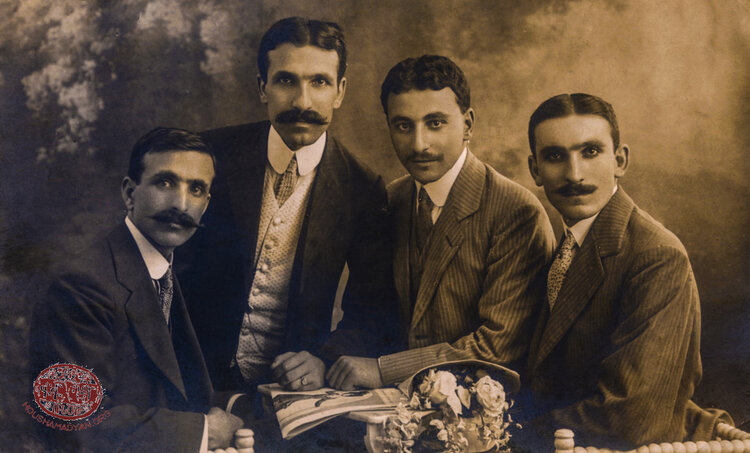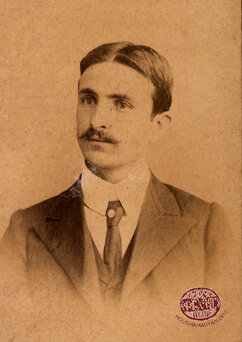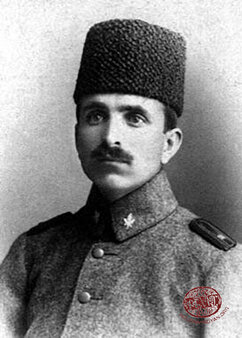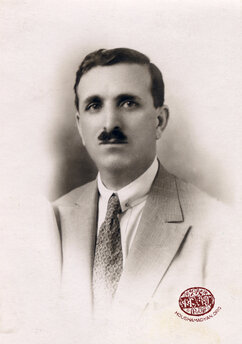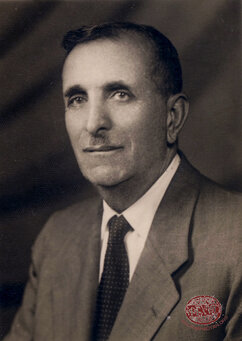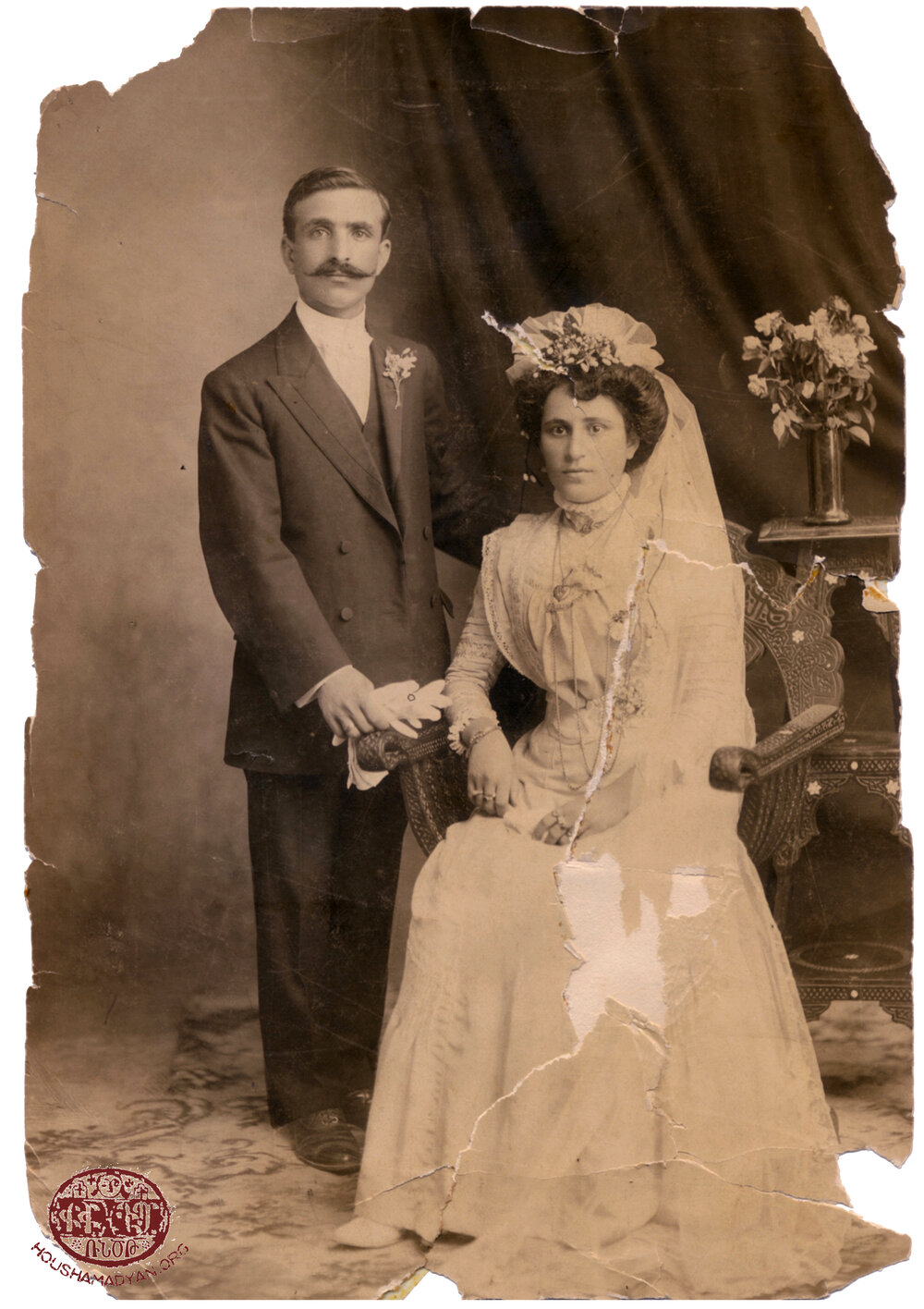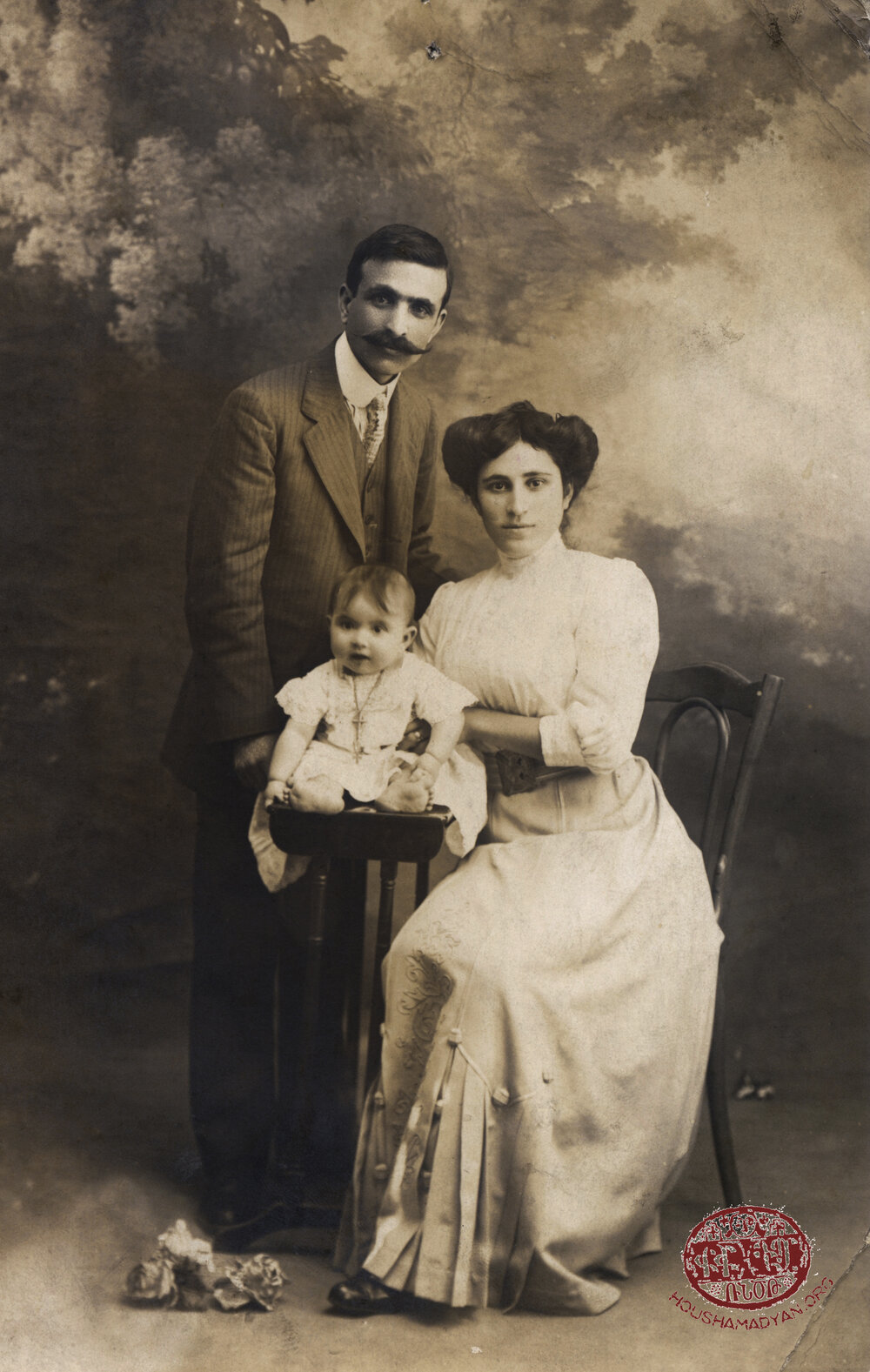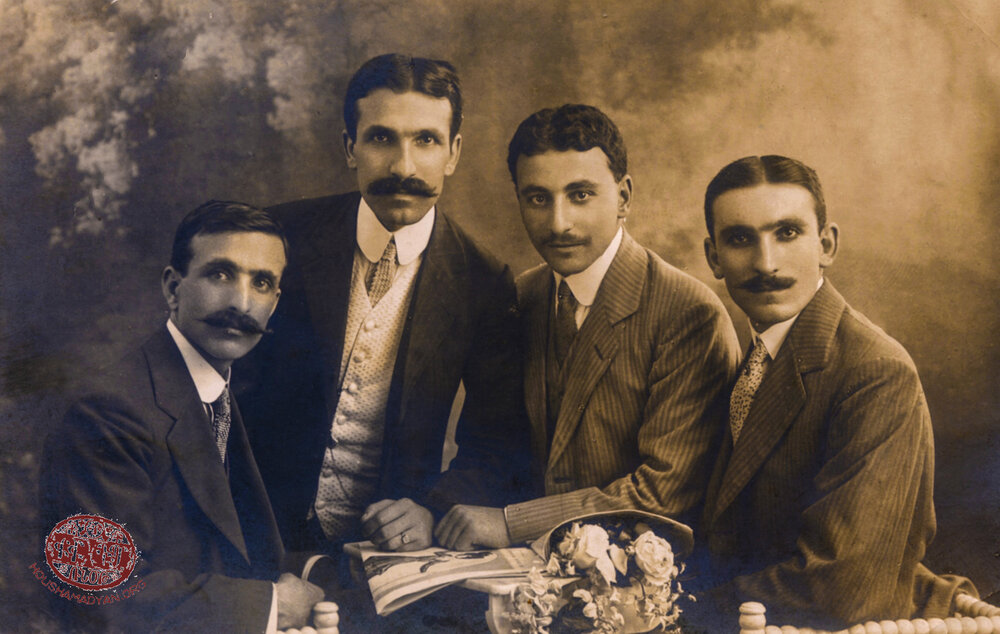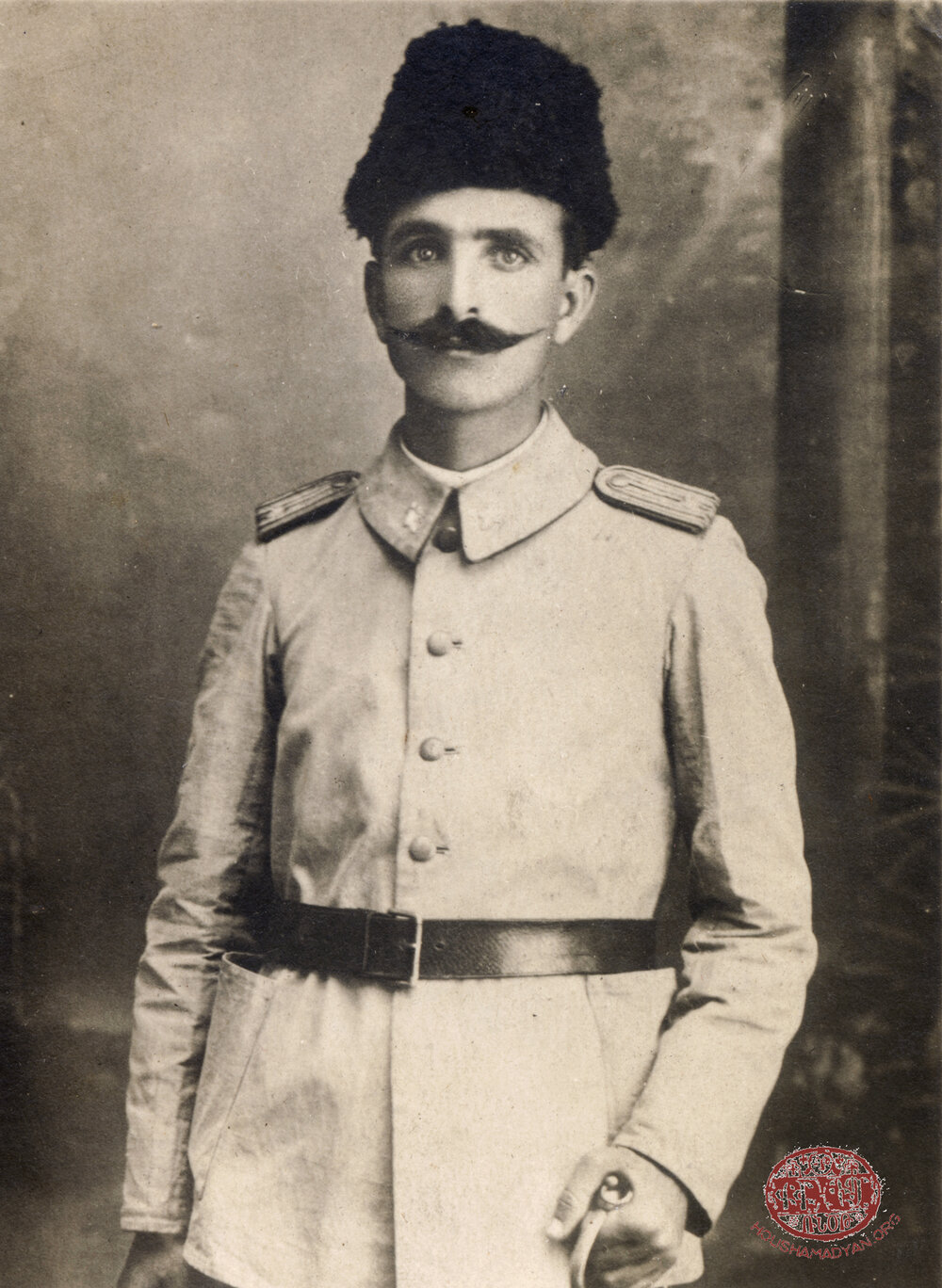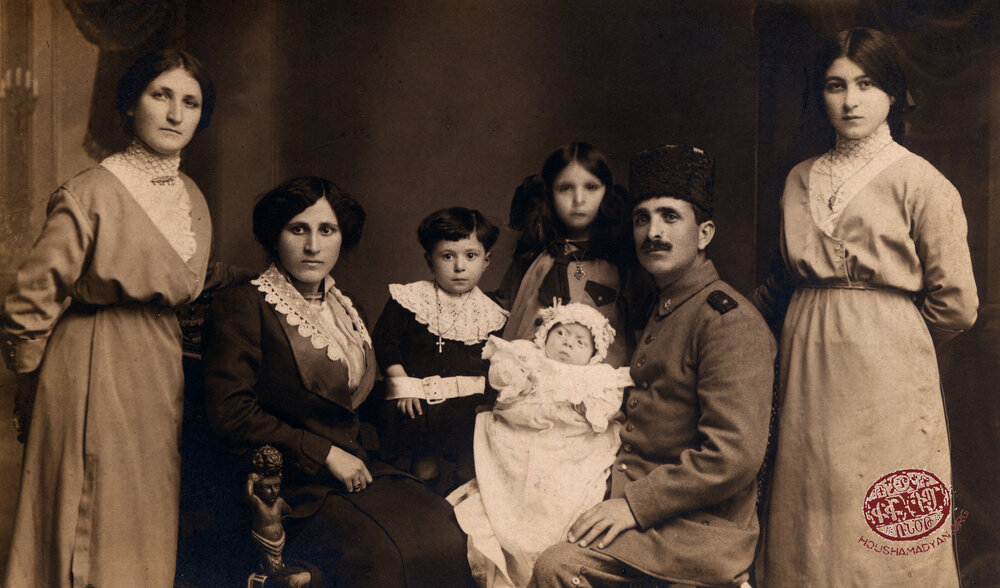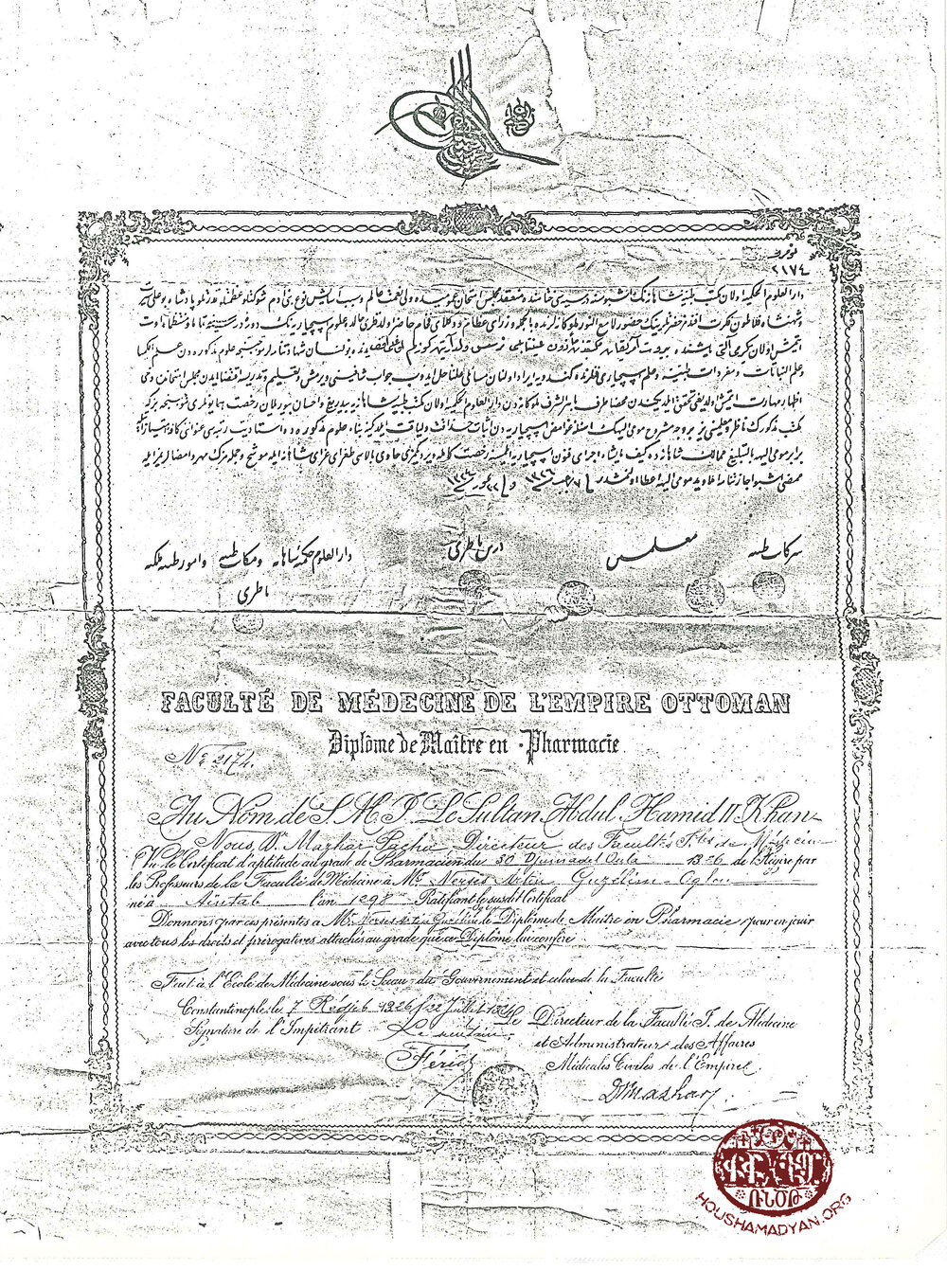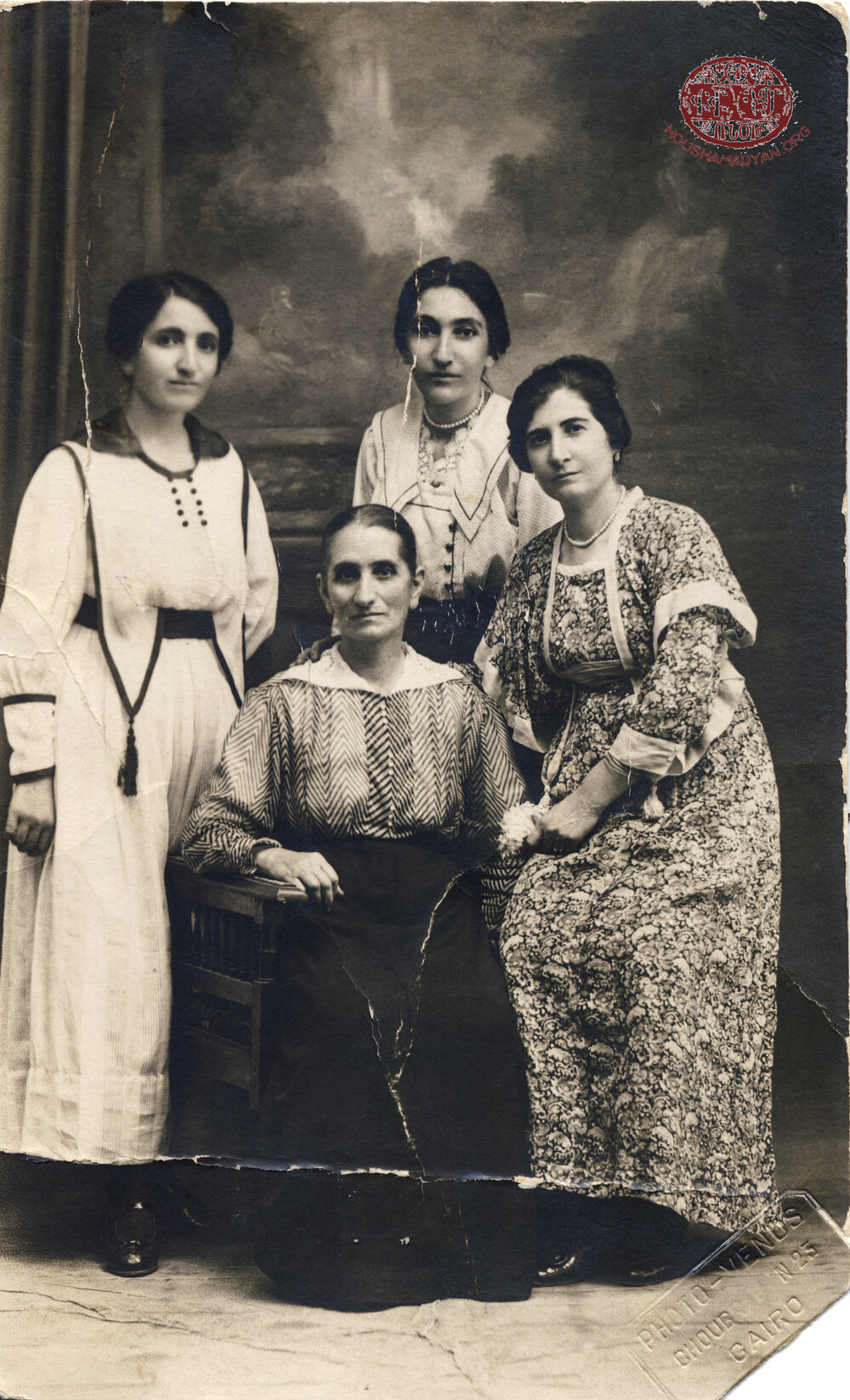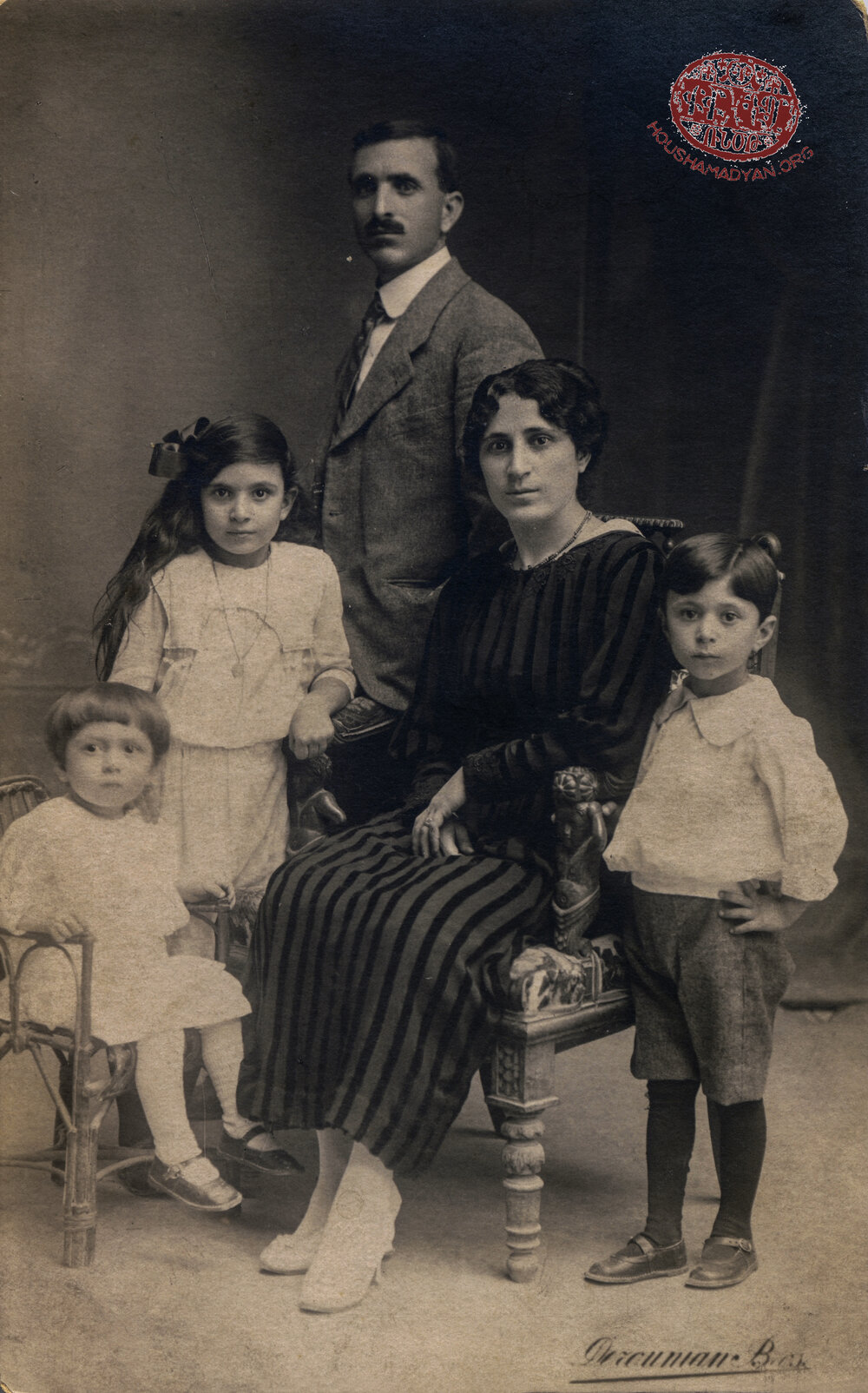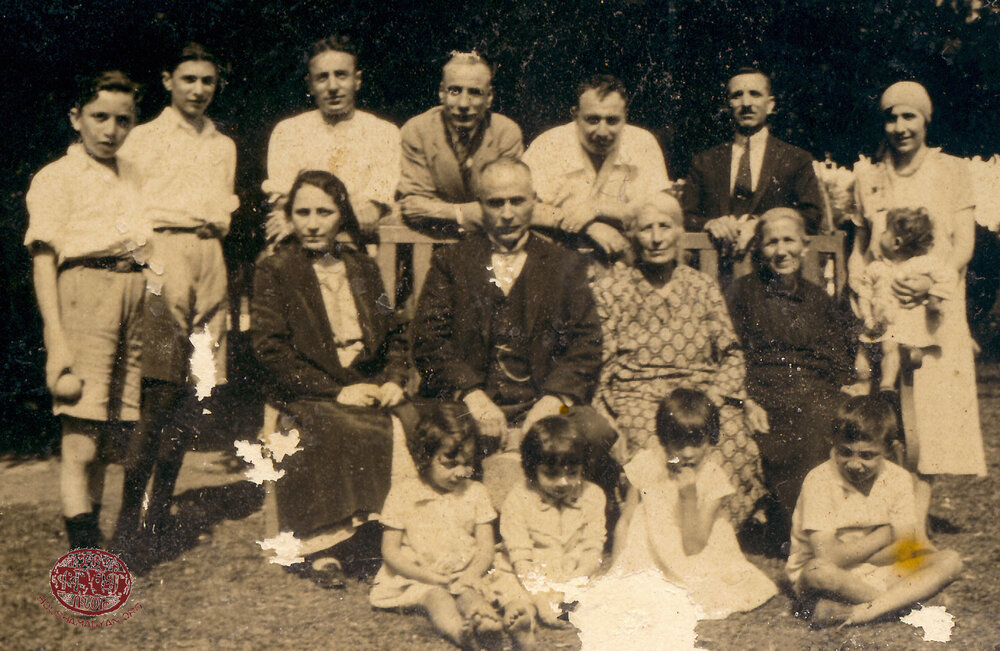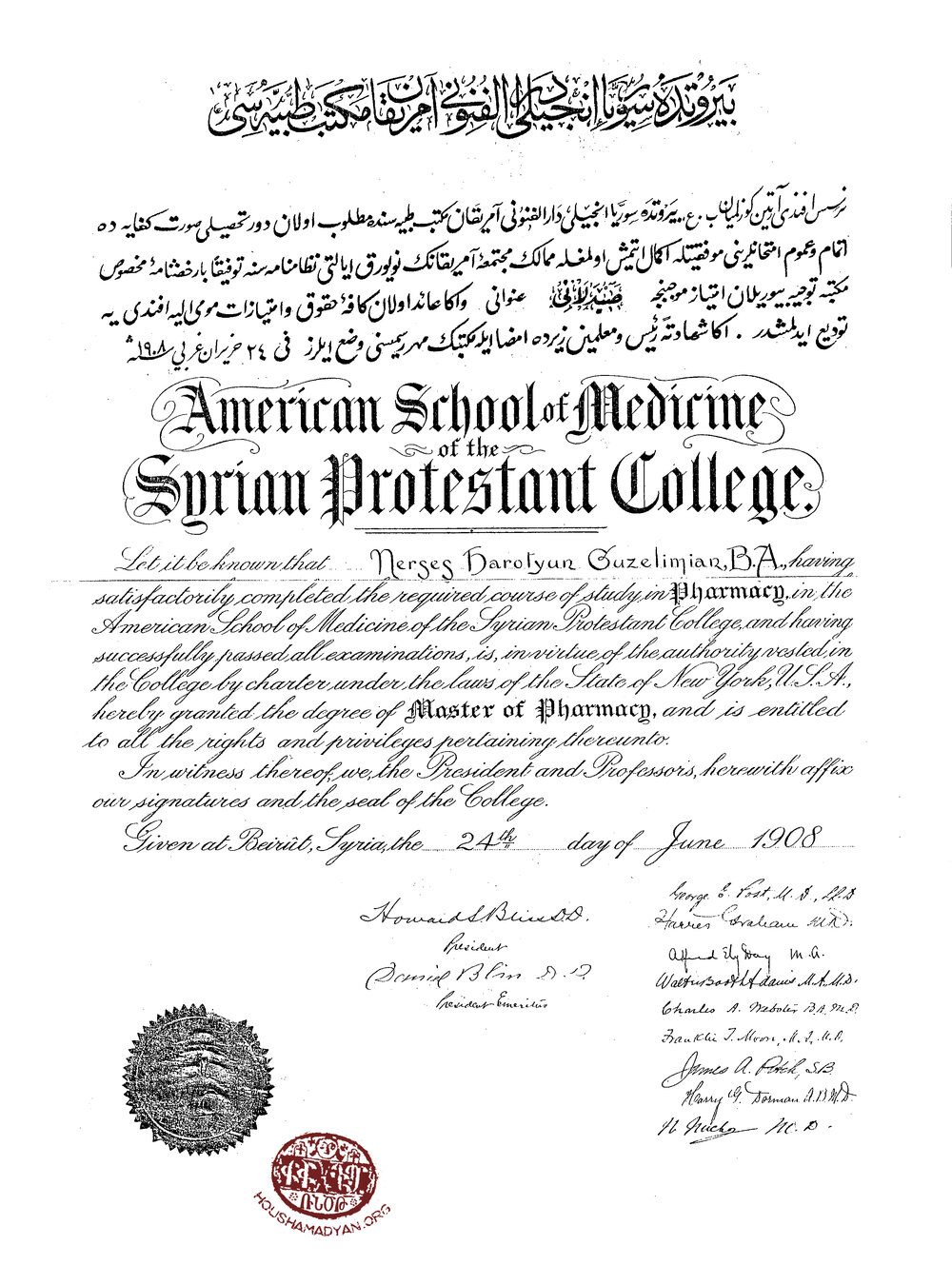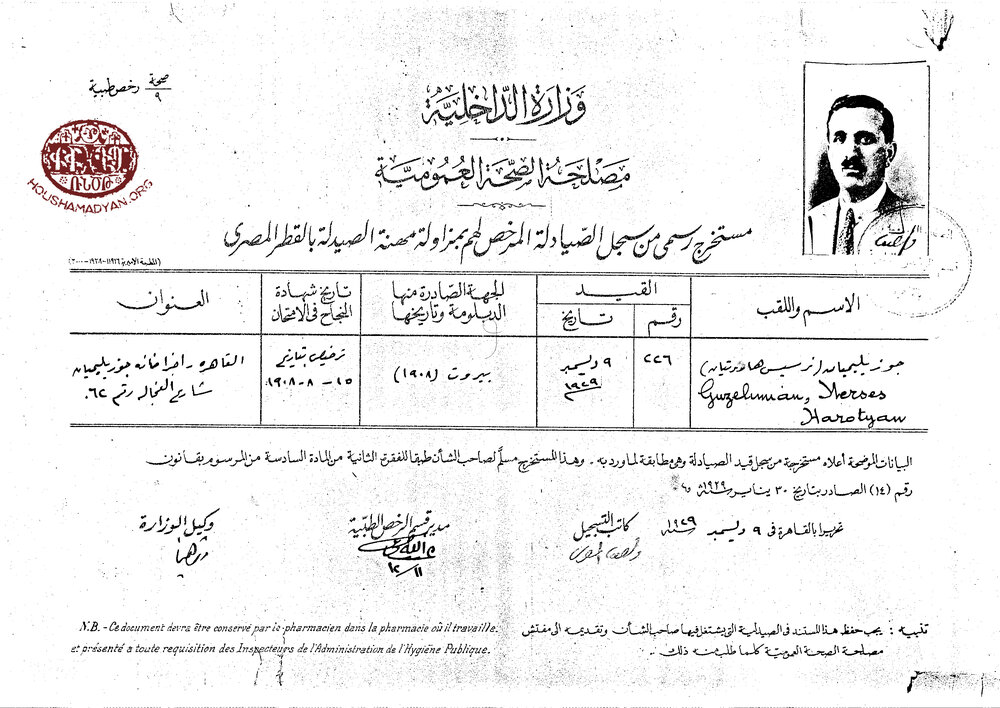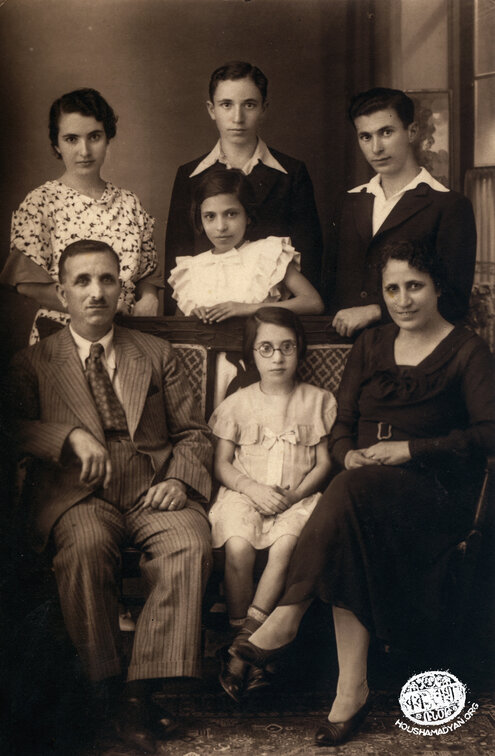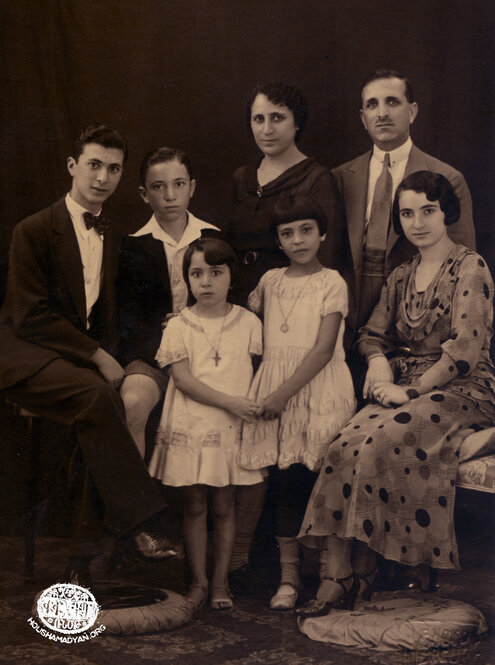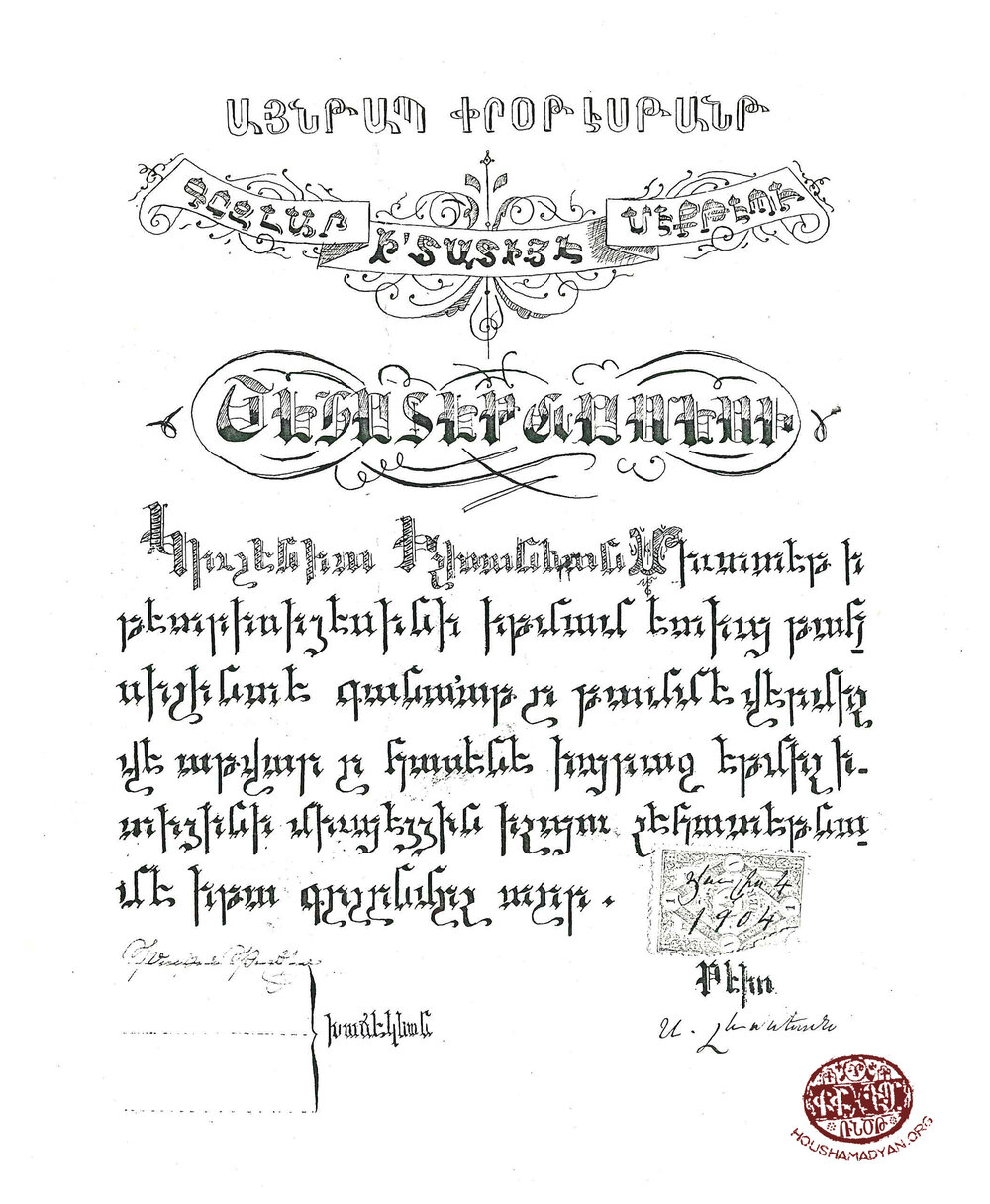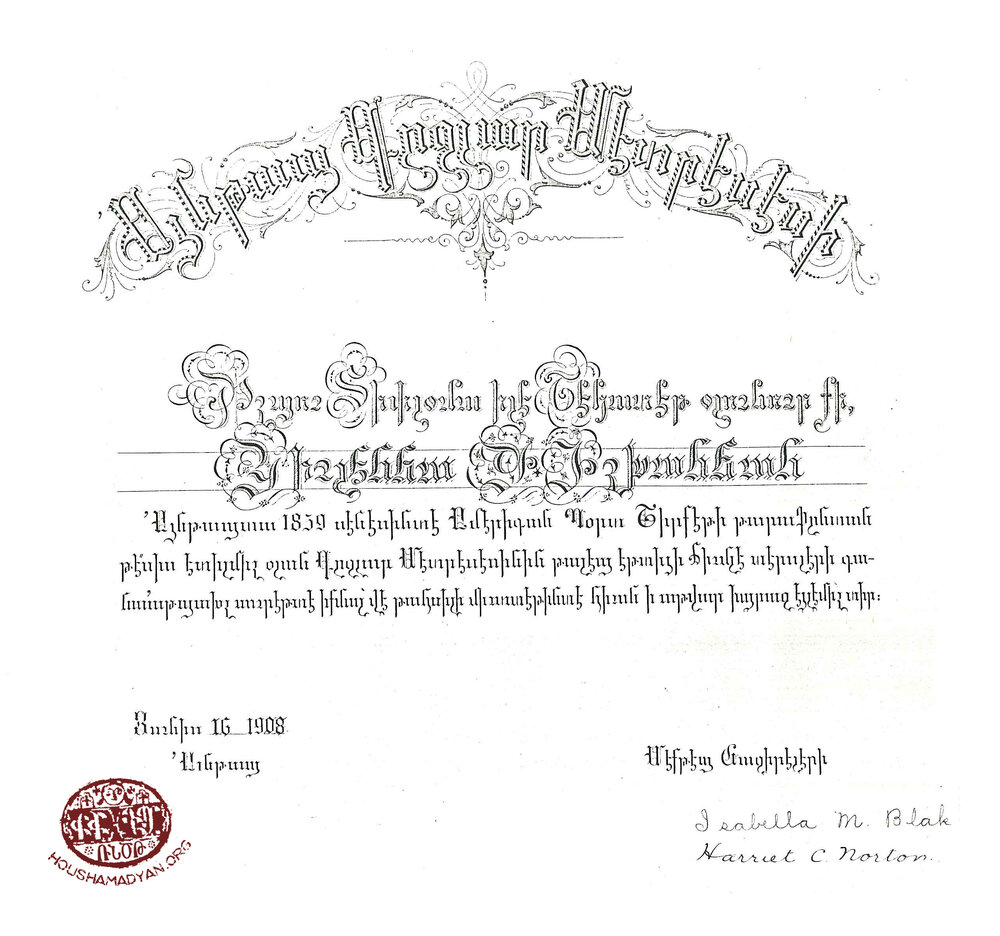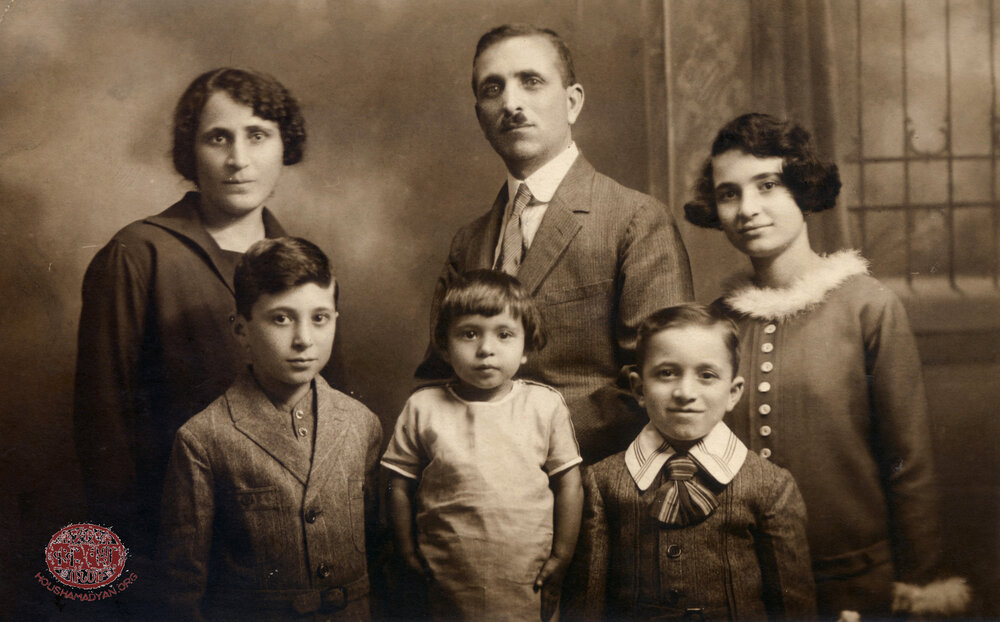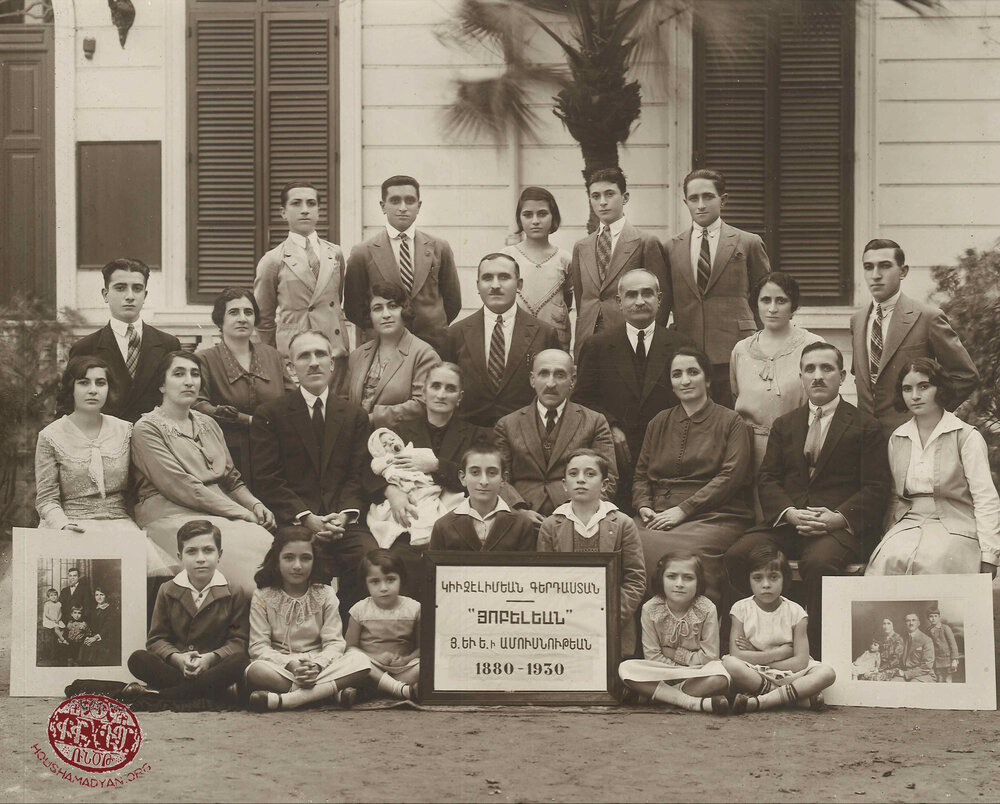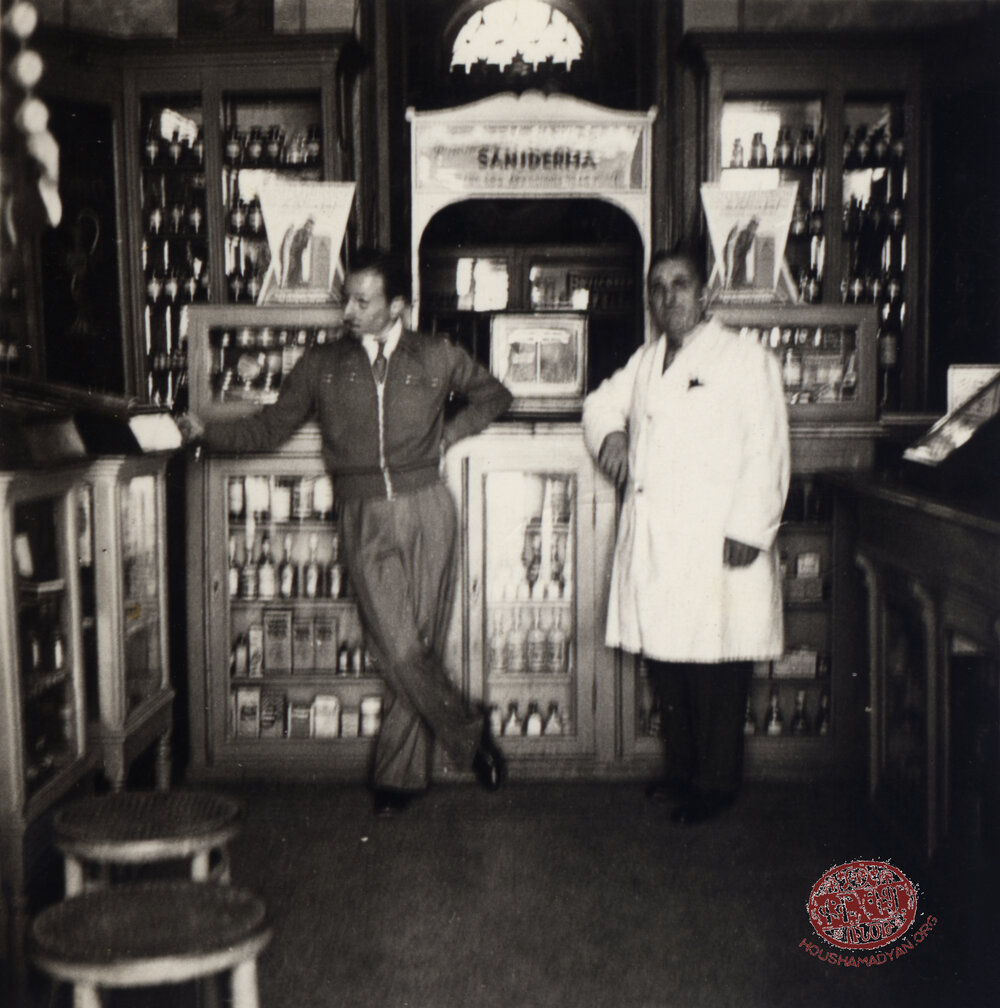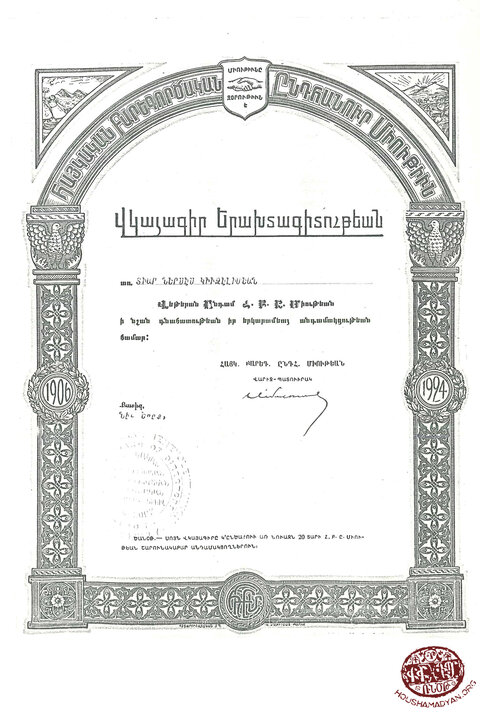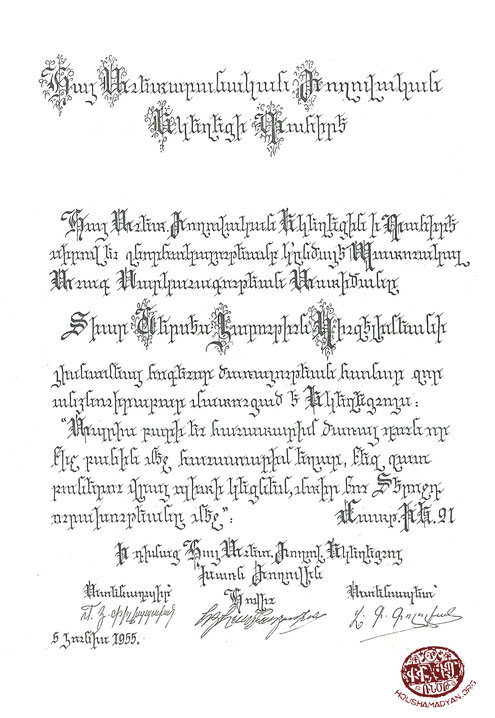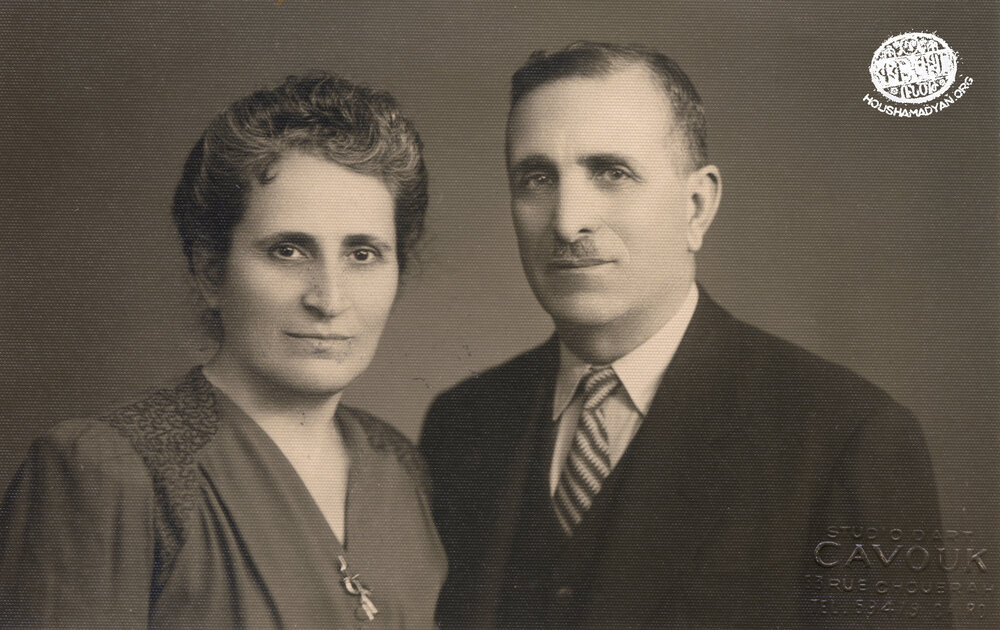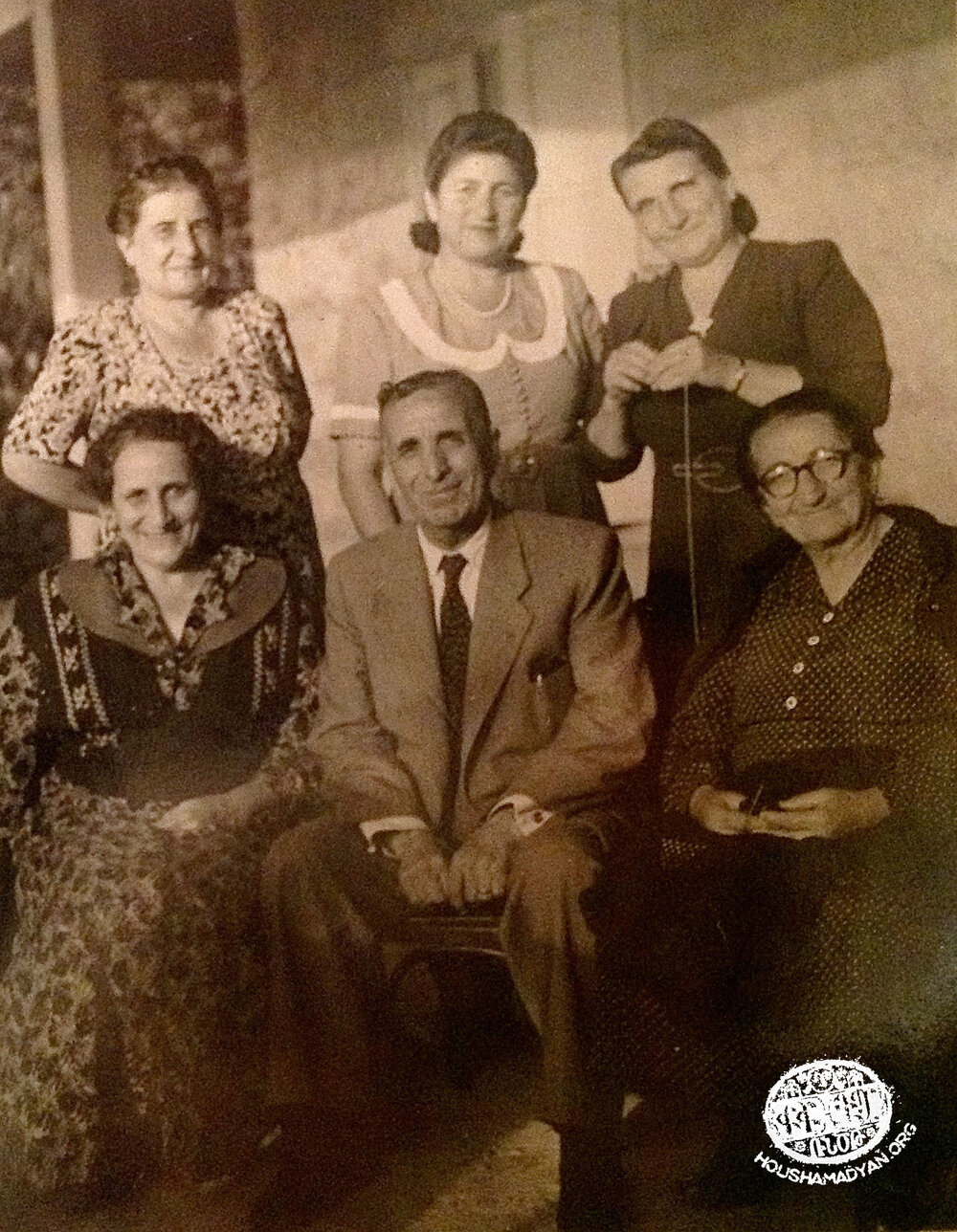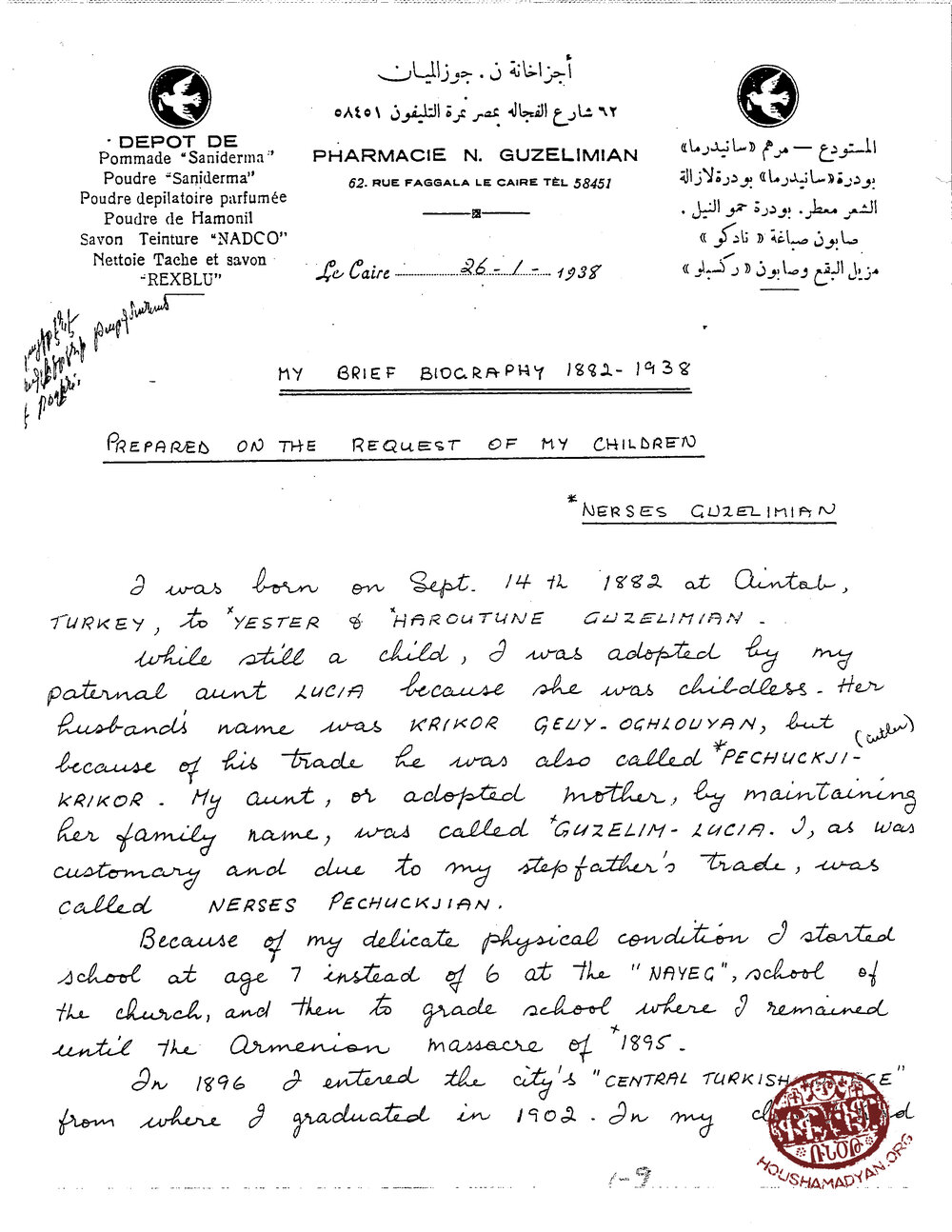Guzelimian Collection - Rancho Santa Fe, California

The Guzelimian family hails from Ayntab. On this page, we present the family’s collection, consisting of a large number of photographs and documents. Access to the collection was granted to us by a member of the family, Vahe Guzelimian.
It is fortunate that one of the family’s ancestors, Nerses Guzelimian, wrote a seven-page autobiography in 1938. This work provides us details of his and his family’s past. The abbreviated history of the family that is provided here is mostly based on these writings by Nerses, as well as information and documents provided to us by his grandson, Vahe Guzelimian.
Nerses Guzelimian was born in Ayntab, in 1882. His mother’s name was Yester (1863-1938, nee Levonian), and his father’s name was Haroutyun/Artin (1860-1934). Aside from Nerses, the family had two sons, Loudere and Khacher, and four daughters – Flora, Yeranouhi, Gulenia, and Mihranoush. Upon his birth, Nerses was adopted by his paternal aunt, Lucia Oghlouyan (nee Guzelimian). She was known as Guzelim Lucia.
Lucia and her husband were childless, and for this reason Nerses’s parents placed him in the care of the Oghlouyan family. Nerses’s adoptive father was Krikor Geoy Oughlouyan, who was also known by the moniker of Bchakdje (knifesmith) Krikor, by virtue of his profession. As a result, Nerses’s family name became Bchakdjian, but only for a short period of time, as we will see.
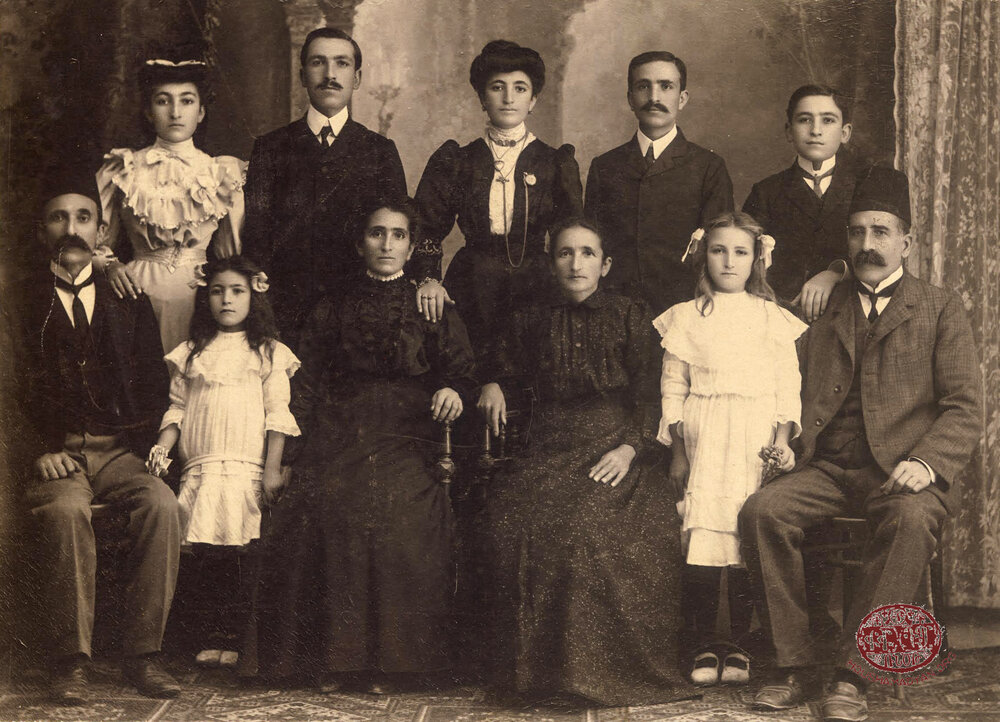
Seated, from left to right – Haroutyun Guzelimian (Nerses’s biological father), Yeranouhi Guzelimian (born in 1899, Nerses’s sister), Yester (nee Levonian, Nerses’s biological mother), Lucia Oghlouyan (nee Guzelimian, Nerses’s adoptive mother), Mihranoush Guzelimian (born in 1895, Nerses’s sister), and Krikor Geoy Oghlouyan (Nerses’s adoptive father).
Standing, from left to right – Gulenia Guzelimian (born in 1890, Nerses’s sister), Khacher Guzelimian (born in 1885, Nerses’s brother), Flora Guzelimian (born in 1887, Nerses’s sister), Nerses Guzelimian, and Loudere Guzelimian (born in 1892, Nerses’s brother).

Nerses’s future wife, Gulenia Ishkhanian, was born in 1891, in Ayntab. The Ishkhanian family were known in Ayntab as yarn dyers. Gulenia's mother was Gullu Ishkhanian (nee Ishkhanian) and her father was Kevork Ishkhanian. Gulenia’s grandmother was Horom Mariam Ishkhanian (nee Karamanougian), and her grandfather was Koupeli Sahagian. He later converted to Islam, and Horom Mariam married for a second time, to Ishkhan Ishkhanian. Gulenia attended the Ayntab Protestant girls’ elementary school, from which she graduated in 1904. She received her secondary education at the American Women’s College of Ayntab, from which she graduated in 1908.
Nerses Guzelimian received his primary education at the school of the Protestant church in the Heyig neighborhood of Ayntab. Beginning in 1896, he attended Central Turkey College, which was an American missionary institution in Ayntab. He graduated from the college in 1902. After the 1895 Armenian massacres, many orphanages were established in Ayntab to care for children who had become orphaned. Beginning in 1896, Nerses’s adoptive parents began working in the orphanage of the Mardin neighborhood of Ayntab. They were entrusted with the care of about 70 children of both sexes. The entire family established residence at the orphanage. Nerses helped his parents in caring for the children, and as a result, was dubbed “Nerses Kardash” (Brother Nerses) by them.
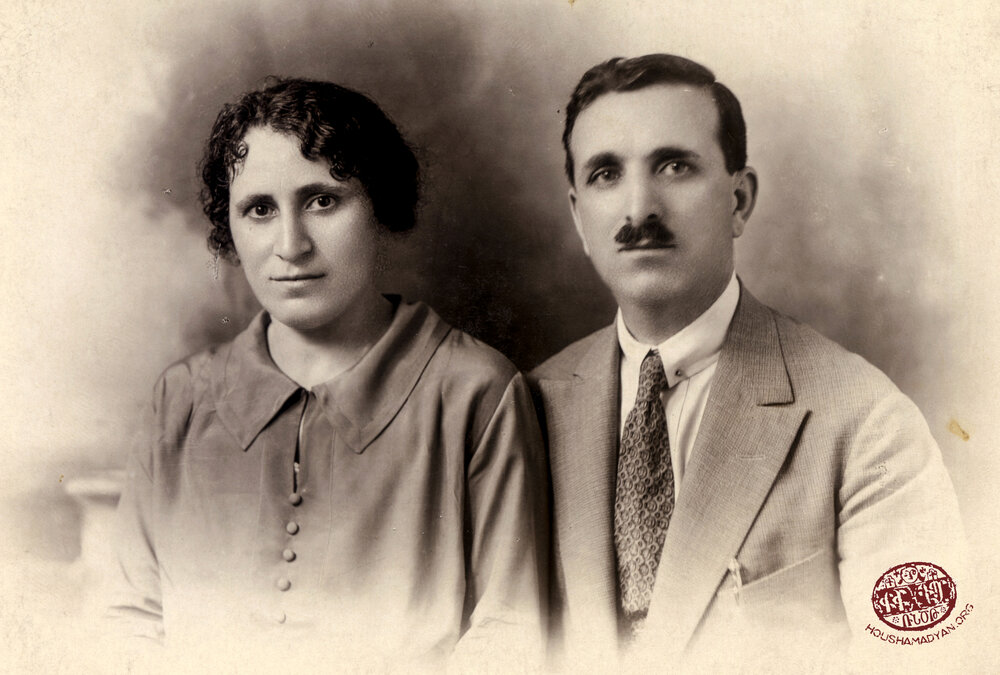

Nerses was deeply involved in the spiritual life of the Armenian Protestant community in Ayntab, and was an enthusiastic member of the congregation of the Heyig neighborhood church. He also served as a Sunday school teacher in the same church. From 1902 to 1905, he served as a teacher in the elementary schools adjacent to the Protestant churches of the Kayadjek and Heyig neighborhoods. He was able to save some of the wages he earned. In 1905, having saved 45 Ottoman pounds, he traveled to Beirut, where he studied pharmacy for a year at the American University of Beirut.
He intended to proceed from Beirut to Egypt, where his biological parents had been living since 1904. But in his memoirs, Nerses writes that in those years, the government had imposed strict restrictions on the issuance of permissions to travel abroad, especially to Armenians. However, a clandestine route had been established, by sea. And so, Nerses embarked on the ship Batladje Muhammad in Lebanon, and reached Egypt as a stowaway, joining his biological family there. In Egypt, he worked for 13 months as an assistant at a local pharmacy. Thereafter, still traveling illegally, he returned to Beirut, where he continued his education as a pharmacist. In 1908, he received his university diploma, and settled down in Egypt. He adopted the family name Guzelimian during his university years. This was the name that appeared on his Ottoman identity papers, and consequently, it was the name that appeared on his university diploma.
In Cairo, he was employed as a pharmacist, a position of prestige, at the New Anglo-American Pharmacy. He remained at that position for six years. In 1910, alongside his biological mother, Yester (his adoptive mother, Lucia, had died earlier in that same year), he visited Ayntab, where he married Gulenia Ishkhanian. Nerses and Gulenia’s first child, Lucia, was born in 1911, and was presumably named after Nerses’s adoptive mother. In 1914, the family moved to Aleppo, where Nerses, in partnership with Haroutyun Ishkhanian, founded a pharmacy. Ishkhanian’s investment in the pharmacy gave him a one-fourth ownership stake. Nerses’ memoirs give the impression that the Ishkhanian family (Gulenia’s family) had, at some point, also emigrated from Ayntab to Egypt. In that same year, the couple’s second child, Vahram, was born.
Then the First World War erupted. Nerses was conscripted into the Ottoman army. In 1917, the couple’s third child, George, was born. Thanks to his expertise as a pharmacist, Nerses was made a mülazimi evvel (first lieutenant). He served in the area of the Amanos Mountains in Cilicia. He spent two years in Tahtaköprü, near Islahiye, and about a year in Osmaniye, working in the military hospitals.
He was then transferred to the Ottoman military hospital in Haifa (Palestine). He was still stationed there when Palestine was captured by British forces. Like many others, Nerses was captured as a prisoner of war, but once it became clear that he had a good grasp of the English language, he was immediately appointed to a responsible position within the same hospital. At the time, the hospital was treating about 1,200 wounded or sick soldiers of the Ottoman army, including approximately 20 officers.
After working at the hospital as a prisoner of war for three months, Nerses was commended for his service by the British forces and released. He was given a free travel ticket, and returned to Aleppo to rejoin his family. There, he revived his pharmacy, which had gone bankrupt, and for two years lived in the city with his wife and children. Then, in 1920, the family once again left for Egypt, with the intention of emigrating to the United States from there. This plan did not come to fruition, and the family continued living in Egypt. Nerses and Gulenia’s two other children, Anahid and Rosine, were born in this country. Nerses’s biological parents, Yester and Haroutyun, also died in Cairo.
In 1955, the family emigrated to Canada, where Nerses and Gulenia died, in 1962 and 1973 respectively. Their daughter Lucia (1911-2002) married Puzant Yeghiayan (1899-1995) in 1935. Vahram (1914-1974) married Lucy Ekmekdjian (1930-1974). George (1917-2010) married Elizabeth Ottilie Vollrath (1937-1972). Anahid (1923-2012) married Souren Noradoungian (1920-2003). Rosine (1926-2007) married Ollie Vaartaja (1917-1984).

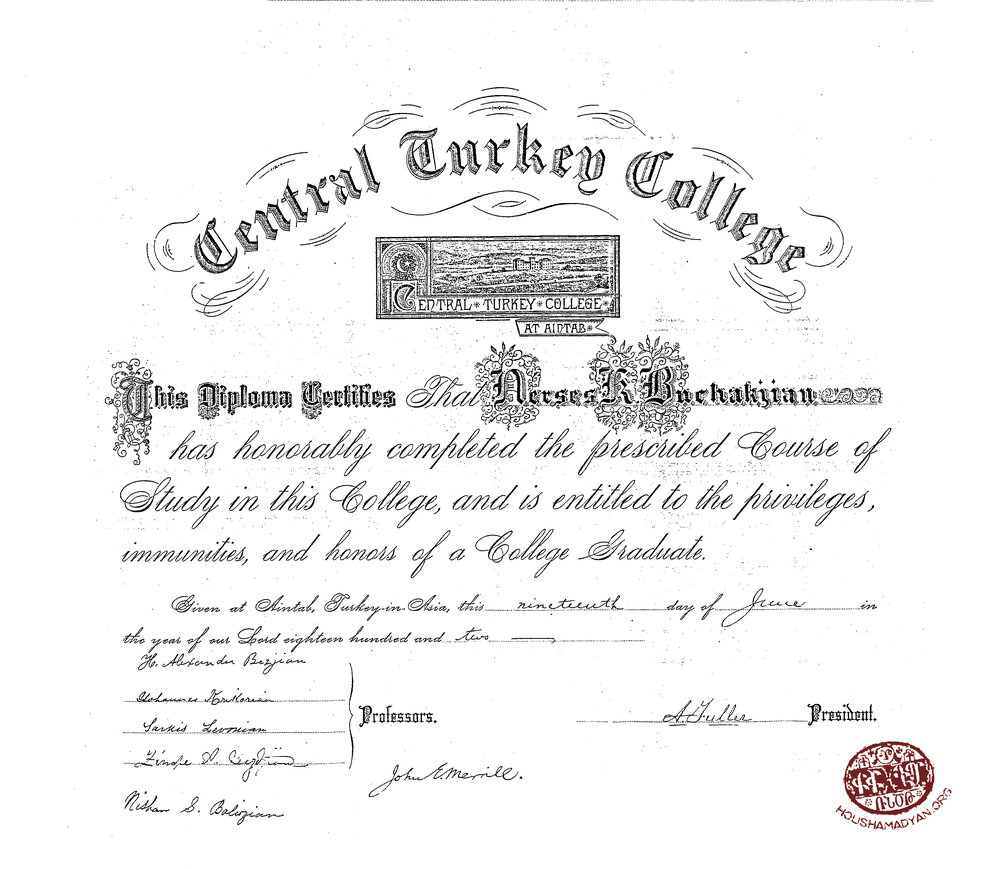

Nerses Guzelimian, wearing the uniform of an Ottoman Army officer and carrying his officer’s sword. During the First World War, Nerses was conscripted into the Ottoman Army. Thanks to his qualifications as a pharmacist, he was made a mülazimi evvel (first lieutenant), and served in military hospitals in the region of the Amanos Mountains in Cilicia. At the conclusion of the war, he was serving at the Ottoman military hospital in Haifa.
Aleppo, 1917 or 1918. While Nerses Guzelimian served in the Ottoman Army, his family lived in Aleppo. This photograph shows Nerses in his officer’s uniform, probably on leave to visit his family and see his newborn child, George.
From left to right – Mihranoush Guzelimian (Nerses’s sister), Gulenia Guzelimian (nee Ishkhanian, Nerses’s wife), Vahram Guzelimian (Nerses and Gulenia’s second child), Lucia Guzelimian (Nerses and Gulenia’s oldest child), the newborn George Guzelimian (born in 1917), Nerses Guzelimian, and Yeranouhi Guzelimian (Nerses’s sister, who would later marry Adour Levonian).

Nerses’s certificate as a pharmacist, issued in 1908. We know that Nerses studied pharmacy at the American University of Beirut. This certificate is probably the government’s validation of his original diploma, issued by the Istanbul state university.
Nerses’s name is given as “Nerses Artin Guzelim Oghlou.” The certificate bears the signature of Mazhar Pasha, who was the head of the medical faculty of the Istanbul state university.

Last row, standing, from left to right – George Guzelimian, Vahram Guzelimian, Protestant pastor (Reverend Hampartsoumian), Nazareth Ishkhanian, Mihran Ishkhanian, Nerses Guzelimian, Emilia Sarkissian-Ishkhanian, Laura Ishkhanian (being held by her mother Emilia).
Seated on the bench, from left to right – Gulenia Guzelimian, Dr. Krikor Sarkissian, Makrouhi Soujian-Ishkhanian, Yester Ishkhanian. Children sitting on the floor, from left to right – Sonia Ishkhanian, Anahid Guzelimian, Rosine Guzelimian, George Ishkhanian.

1) The Guzelimian family in Cairo. Seated, left to right – Nerses Guzelimian, Rosine Guzelimian (born in 1926), and Gulenia Guzelimian. Standing, left to right – Lucia Guzelimian, Anahid Guzelimian (born in 1923), George Guzelimian (behind Anahid), and Vahram Guzelimian.
2) The Guzelimian family in Cairo. Seated, left to right – Vahram Guzelimian, George Guzelimian, Rosine Guzelimian (standing in front of George), Anahid Guzelimian (to the right of Rosine), Gulenia Guzelimian (behind her daughters), Nerses Guzelimian, and Lucia Guzelimian (seated).


The Guzelimian and Ishkhanian families in Cairo, in 1930. The photograph was taken on the occasion of the 50th wedding anniversary of Haroutyun/Artin and Yester Guzelimian.
Last row, standing, from left to right – Harry Guzelimian, George Ishkhanian, Zabel Haserdjian, Vahram Guzelimian, and Yervant Ishkhanian.
Second row, standing, from left to right – Levon Guzelimian, Hripsime Guzelimian (nee Levonian), Lucy Guzelimian (nee Levonian), Loudere Guzelimian, Apraham Ishkhanian, Gulenia Guzelimian, and Albert Aroyan.
Seated on the bench, from left to right – Nvart Levonian (nee Guzelimian), Gulenia Aroyan/Haserdjian (nee Guzelimian), Khacher Guzelimian, Yester Guzelimian (nee Levonian) holding Harry Guzelimian (born in 1930) in her arms, Haroutyun Guzelimian, Flora Ishkhanian (nee Guzelimian), Nerses Guzelimian, and Lucy Yeghiayan (nee Guzelimian). Seated on the ground, from left to right – Puzant Guzelimian, Sirvart Ishkhanian, Rosine Guzelimian, Aram Haserdjian, George Guzelimian, Armine Ishkhanian, and Anahid Guzelimian.
Interestingly, the photographs held by those the very left and right of this photograph portray absent family members. The photograph held on the left portrays the family of Mihranoush Beredjikian (nee Guzelimian, Nerses’s sister) in the United States. The photograph on the right portrays the family of Yeranouhi Levonian (nee Guzelimian, Nerses’s sister). Yeranouhi was married to Adour Levonian, and their family lived in Aleppo. The photograph also shows their children, Hrair and Arpine.
1) A certification of appreciation presented to Nerses Guzelimian by the New York Center of the Armenian General Athletic Union (HMEM), for his long years of service to the organization.
2) A certificate of appreciation, dated 1955, presented to Nerses Guzelimian by the Armenian Protestant church of Cairo. The certificate was presented to Nerses in gratitude for 50 years of supporting the church. Alongside the certificate of appreciation, he was granted the title of Senior Deacon.

Vahe Guzelimian, Nerses’ grandson, continues preserving Nerses’ legacy by maintaining a family tree of all the people who share DNA with Nerses (over 5,200 people). This tree is public and is available at http://www.guzelimiantree.com

